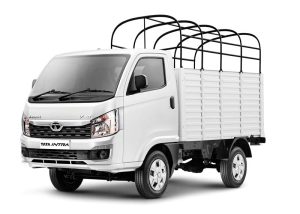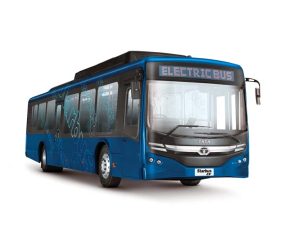In a mega unveil, Tata Motors launched 21 products. Deepti Thore shares more on the strategy based on customer needs of high vehicle utilisation.
Tata Motors unveiled 21 new Commercial Vehicles (CVs) across all segments catering to varied duty cycles as well as special applications. Designed and engineered to meet the evolving needs of Indians and it’s growing demand for efficient transportation, the new range, according to Girish Wagh, Executive Director, Tata Motors will enhance Tata Motors’ already established ‘Power of 6’ customer value proposition. With the new range of vehicles, Tata Motors is looking to address specific duty cycles on an application-to-application basis. Aspiring to redefine transportation, the new range is modular and claimed to deliver higher productivity and lower Total Cost of Ownership (TCO). Pointing at the newly launched range, Wagh said, “The engines of infrastructure development, consumer consumption and e-commerce powering the Indian economy require continued transportation support to run seamlessly. Being the leader in commercial vehicles, we continue to deliver superior value propositions to customers by introducing smarter, future-ready products and services.” “Our vehicles are ideal to fulfil the customer need of high vehicle utilisation for more revenue with lower costs for higher profits,” he opined.
Addressing a wide spectrum
The comprehensive range incorporates the latest advancement in technology like refined powertrains and brings about significant upgrades in comfort and convenience. The vehicle range launched by Tata Motors includes four Small Commercial Vehicles (SCVs) and pickups, five Intermediate & Light Commercial Vehicles (I&LCVs) and seven Medium & Heavy Commercial Vehicles (M&HCVs). The company has also thought it fit to introduce five new buses after a dull fiscal for the bus segment. To offer more agility in the last-mile, Tata Motors is offering four multi-purpose vehicles in the SCV segment. In the I&LCV segment, it has introduced vehicles with increased deck length, ultra sleek cabins and with a Gross Vehicular Weight (GVW) spanning across tonnage, from four-to-18-tonne. To find relevance with a larger customer base, the company has also thrown into the mix Compressed Natural Gas (CNG) drivetrains. The M&HCV segment, on the other hand, includes a combination of ‘Construck’, tractor-trailer and a rigid truck range with an assurance of higher fuel efficiency. Apart from these, Tata has also introduced passenger commercial vehicles including an e-bus equipped with segment-first features and holistic solutions for passenger transportation.
The SCV and Pickup range
Leading the SCV segment, Tata Motors is claimed to provide a livelihood to around 30 lakh people by giving them self-employment opportunities in rural and urban expanses. To persist with its aspiration of revolutionising last-mile transportation, the new SCV and pickup range while offering a safe, smart and value-creating opportunity is also claimed to maintain versatility. This versatility is extended across applications including in market logistics, distribution of fruits, vegetables, and agri products, beverages and bottles, Fast Moving Consumer Goods (FMCG) and Fast Moving Consumer Durables (FMCD). It is also extended to e-commerce, parcel and courier, furniture, packed LPG cylinders, dairy, pharma and food products, refrigerated transport, as well as waste management applications. The range banks on the Ace, Intra SCVs on one end of the spectrum and the workhorse Yodha at the other end.
The Tata Ace Petrol CX with a cab chassis is the lowest priced four-wheeler used for multiple applications. Claimed to be the only four-wheeler SCV powered by a two-cylinder engine, its value proposition is a profitable last-mile distribution and sustainable operations. It offers cargo box options including cab chassis, flatbed and CLB(half deck). The Ace Gold Diesel+ is the new diesel variant of the popular Tata Ace Gold which comes with a claim of higher fuel efficiency and improved driveability and overall drive experience. Available in three colour variants – Irish Cream, Titanium White and Azure Blue, the new mini-truck is loaded with attributes to help elevate the vehicle uptime in terms of duty cycles, load and speed besides the earning potential.
In the smart pickup range, the Intra V30 High deck, makes its mark by offering end-to-end, complete solutions. Boasting of a ‘Premium Tough’ design, the pickup is for those looking at lower initial acquisition costs. Tata Motors is offering easy finance options and ready to use features. The next-gen vehicles are claimed to up the ante with contemporary build including a wide walk through cabin and claims of car-like interiors. With an objective to offer a low TCO, the company has launched the sleek and stylish avatar of the Winger – Winger Cargo. The cargo variant is expected to help meet the growing needs of e-commerce distribution by offering a complete delivery solution. Equipped with a high-utility dashboard, the vehicle, in keeping with times, also offers a dedicated branding space on its side panels. On the utility front, it is designed to offer easy loading and unloading of cargo.
The I&LCV range
Tata Motors is happy with its growth in terms of size, scale, presence and popularity in the I&LCV segment. Claimed to have increased the profit potential of its customers, the range of four- to 18-tonne GVW is for those looking at solutions for the last-mile and medium or long-haul. Introduced with a longer deck length, the new range is designed to meet the evolving needs of the growing e-commerce segment. Providing better maneuverability and faster turnaround, the I&LCV has been launched for e-commerce servicing. In the 18-tonne segment, Ultra T.18 SL is said to offer a best-in-class payload of 11.5-tonne. It is offered in multiple deck lengths (20-24 ft.) and is best suited for long haul transportation. The 407G, on the other hand, is positioned as a CNG Pick-up truck for last-mile delivery. Available with a 10 ft. load tray, the four-tyre CNG truck comes with a large loading area and claims to offer a high performance benchmark. Built with a 10 ft. load body and shorter-wheelbase, the LPT 510 is for maneuvering the narrow lanes. The all-steel cabin is claimed to offer higher safety for drivers. Enhancing driver comfort, the new Tata Ultra T.6 is launched for faster turnaround. Deemed fit for urban and semi-urban transportation due to its compact size, this vehicle exhibits a modular design with walk through features.
The M&HCV range
Tata Motors has delivered over 25 lakh trucks so far including over one lakh BSVI M&HCVs. The M&HCVs from Tata Motors are known to offer a wide range including fully-built body options of load bodies, tippers, tankers, bulkers and trailers which carry out good movements. For example, market load, agriculture, cement, iron and steel, container, vehicle carrier, petroleum, chemical, water tankers, Liquid Petroleum Gas (LPG), FMCG, white goods, perishables, construction, mining and municipal applications. This segment is said to have gained traction and touted as one of the fastest growing segments.
The new M&HCV vehicles are equipped with features offering superior performance and lowest TCO. Built for the heavy-duty applications, the new Signa 5530.S offers an enhanced performance and faster turnaround. This 4×2 tractor is designed to meet needs of heavy-duty applications. To enhance the flexibility across duty cycles, Tata Motors has launched Signa 4623.S, a 46-tonne GCW tractor designed for varied duty cycle and applications. Tata has also introduced a vehicle with industry-first Electronic Stability Control (ESC) system, Signa 4625.S with ESCsmart active safety technology for vehicle directional stability preventing rollover of vehicle by selective actuation of service and engine brakes. Signa 4221.T, on the other hand, is built on a five-axle platform providing higher fuel efficiency with a combination of pusher and tag axles at the front and the rear. Developed for a tractor-trailer application, the Signa 4021.S with a axle configuration of 4×2, offers better operational efficiency. Imparting the highest payload in the three-axle truck segment, Tata’s Signa 3118.T is India’s first 10-wheeler 31-tonne truck with a 12.5-tonne lift axle. The newly launched Prima 2830.K RMC with Rear Engine Power Take-Off (REPTO), is claimed to reduce operating costs by up to 11 per cent.
The bus range
Commercial passenger vehicle segment was hit hard during the pandemic as people were shying away from shared mobility. Addressing this issue, Wagh mentioned, “Post the second wave we have started witnessing demand recovery on the segment. Gradually people are moving to earlier modes of transportation, especially the ones who are vaccinated. With this we see demand for buses getting back.” He further added that for intra-city bus services, barring the manufacturing, the IT and services of this sector were impacted. With employees moving back to office their need for bus transportation continues to rise. To address this need, Tata Motors has launched a few buses meeting the new regulations imposed by the Government last year. As per the new regulations, the new buses will be 13.5 m long instead of 12 m. Tata Motors is the first to launch a 13 m bus. With schools reopening again, the demand for school buses is also increasing and to meet this demand Tata Motors has also launched school buses.
Tata’s passenger CV range focuses on passenger and driver comfort with operator profitability as the underlying theme. Ranging from intra-city school or staff transportation to inter-city travel, the new Tata bus range offers a greener drivetrain mix with CNG, LNG, Hydrogen Cell and BEVs. The new range of passenger commercial vehicles include the Winger 15S equipped with segment-first comfort features for a luxury ride with a seating capacity of 15+D. Designed for zero-emission urban mass mobility, the Tata 4/12 m Starbus Low Entry electric bus identified as the apt fit offers a seating capacity of 35+ D + wheelchair. To meet school and transportation needs, Tata has also introduced the Starbus 2200 series range while on the other hand, the Cityride Prime LPO 1315, a 10.72 metre bus offers spacious passenger salon and wider gangway. The 13.5 m Magna coach is ideal for luxurious inter-city travel with enhanced passenger comfort.
Dealing with covid19
Talking about launching these vehicles amid the ongoing pandemic crisis, Wagh shared the reason behind an optimistic outlook for the second half of 2021. Commenting on the CV industry outlook for FY22, Wagh stated, “Since the Covid-19 second wave we have seen gradual demand recovery across sectors including M&HCV and I&LCVs. The SCV segment has remained resilient through the crisis.” Admitting to the headwinds in the form of rise in operational costs for its operators attributed to fuel price hikes and hiked vehicle prices, Wagh expressed confidence in the demand recovery and rising freight rates to bring profitability back. To counter the high diesel prices, Wagh expressed hope in the new CNG range offering a price advantage and better operating dynamics to operators. He cited the example of an estimated 40 per cent I&LCVs having migrated to CNG. “We are re-engineering this product range to address the issue faced by the transporters,” he exclaimed.
Tata Motors new range is banking on the ability to drive customers towards understanding an even finer segmentation of applications and usages. Developed in a modular format with many aggregates being built separately, the new range can be made available for the export market as well, confirmed Wagh. Talking about the electrification of buses, Wagh mentioned, “Being the leaders in phase one of Fame II for electrification of vehicles, we are supporting the government for city transportation. We have already supplied more than 609 buses.” For electrification, the company is working on a modular vehicle platform and software separately. “We are working with IOCL to deliver the first fuel-cell electric buses in the country,” revealed Wagh. He also spoke of working with few ecommerce players to in turn electrify their last-mile distribution vehicles. The company is also working on setting up charging infrastructure, financial requirements or support to ensure sustainable operations. Apart from this, the company is also working on a strategy to reduce the use of semiconductors without impacting any of the functionality, Wagh concluded.






























